The position of a bonsai tree in a pot changes and influences the landscape you want to create.
The golden ratio (1:1.618) can be used to choose the right pot as well as position a bonsai tree to create a visually pleasing composition. Balance and unity, contrast and emphasis, and rhythm and movement are keys to finding the right angle of the tree.
Golden ratio and bonsai positioning
The golden ratio, which is approximately 1:1.618, has been found to be aesthetically pleasing to the human eye and can be used for positioning a bonsai tree in a pot.
This mathematical concept is known to humans for a long time and has been used in art and design for over 2000 years. The ancient Greeks (sculptures) and Egyptians (pyramids) are two of the most well-known cultures that first used this principle in art.
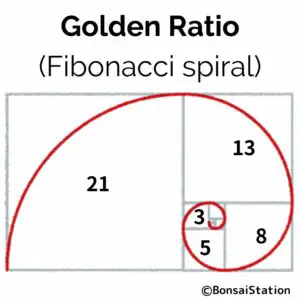
Fibonacci spiral
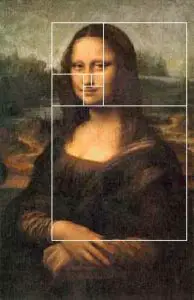
Mona Lisa and the golden ratio
To create a good composition, we can draw a spiral called the Fibonacci spiral using squares whose side lengths correspond to the golden ratio. Mona Lisa, a painting by Leonardo Da Vinci, is known to have a well-balanced composition and you can see that it does follow certain golden ratio proportions.
Historically in Japan as well, the ratio of 3:5 is told to create a beautiful design, which is used in positioning a bonsai tree in a pot. This ratio is 1:1.66… and approximates the golden ratio. You can see these numbers (3 and 5) in the Fibonacci spiral above.
The reason for the golden ratio being aesthetically pleasing is still subject to debate but one of the theories says that this pattern appears regularly in nature such as the branching of trees and the arrangement of leaves on a stem, and we find it “natural” and comforting.
In any event, the golden ratio creates a sense of balance and harmony in a form and it can be applied to the positioning of a bonsai tree in a pot to create a visually pleasing composition.
How to choose the right pot

Porcelain bonsai pot
Choosing the right pot for your bonsai tree is the first step for making bonsai because bonsai is an art form that aims to create a natural landscape with tree(s) in a pot, where the pot represents the terrain where they stand.
To choose the right pot for your bonsai tree, it is important to think about whether the pot matches the bonsai aesthetics. Specifically, size, depth, color, and shape should be considered with regard to bonsai aesthetics.
It is important to note that this is just a guideline you can explore multiple possibilities outside of this based on the size and style of your bonsai tree.
Size and depth
Size
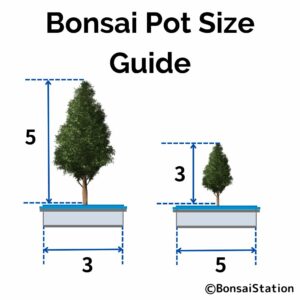
Bonsai pot size guide
The size and depth of the pot are important to the overall appearance of your bonsai tree. As a general rule of thumb, the ratio of the pot’s height to its width should be approximately 1:1.618, or 3:5.
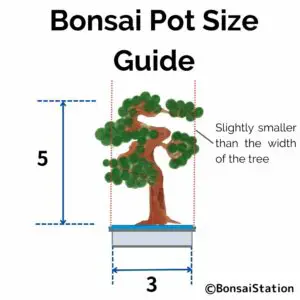
Bonsai pot size guide
It may be a good idea to choose a pot that is slightly smaller than the width of the tree so that the tree looks bigger than it actually is. But be careful when choosing a small-sized pot. If your tree is not strong enough or has not fully matured, putting a tree in a pot with a very confined root space might not do well with the tree.
Depth
The depth of the pot depends on the style you want to create.

Bonsai pot depth
| Pot Depth | Bonsai style |
| Deep | Cascade |
| Medium | Slanting |
| Shallow | – Upright – Forest |
Color and shape
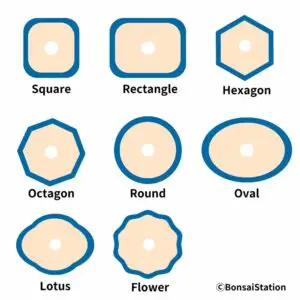
Different types of bonsai pot shape
The color and shape of the pot also contribute to the overall aesthetics of the bonsai tree. The pot should complement the tree’s style and species and should not be too distracting or overwhelming.
For example, the main color of coniferous trees such as spruce and pine is green. So, planting these trees in a green pot blurs their beauty, and planting them in a red/yellow pot is too distracting for the viewers.
Also, planting cherry blossom bonsai trees in a rectangle bonsai pot may convey a too rigid and assertive impression, which might not suit their lovely flowers.
If you are not sure which pot to choose, neutral colors, such as brown or tan, are often a safe choice because it is the color of the earth. A round (oval) pot is also a solid choice because it works well with almost all tree species and styles.
How to position the tree in the pot
Choose the front of the tree
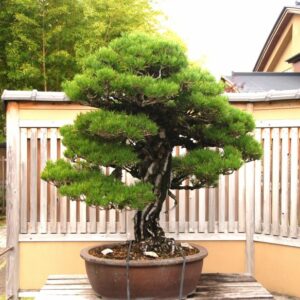
Front of a bonsai tree
Before you position the tree in the pot, choose a front for the tree. The front side of a bonsai tree is the side that looks most aesthetically pleasing from the viewing angle.
The front of a bonsai tree should be carefully chosen based on the tree’s most appealing visual aspects, including the surface roots, the shape and structure of the trunk, the positioning of the branches, and the arrangement of the foliage.
For more about how to choose the front of your bonsai tree, please read the following post.
Position the tree in a pot
After you’ve selected the right pot and the front, you’re ready to position your bonsai tree in the pot.
A basic rule for positioning
There is a basic rule for positioning a tree; if you chose a pot that has wider and shorter sides like a rectangle, make sure to position the front of the tree along the wider side of the pot. The wider side of the pot can support the visual weight of the tree and give it a stable appearance.
You might be able to explore using the shorter side as a front and the wider side as depth but I think it is a very advanced or avant-garde bonsai design that needs years of experience (and it is not at all conventional).
Apply the golden ratio
As I said earlier, the golden ratio can also be applied to the positioning of a bonsai tree in a pot to create a visually pleasing composition.
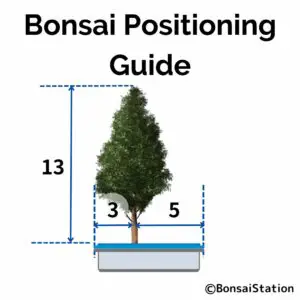
Bonsai positioning guide
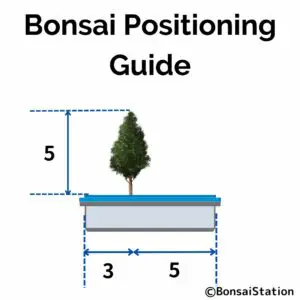
Bonsai positioning guide
For example, if your pot is 8 inches wide, you would divide it into two sections of 3 inches and 5 inches. You can then position your bonsai tree between these two sections in the pot.
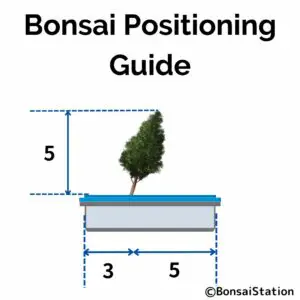
Bonsai positioning guide (slanting)
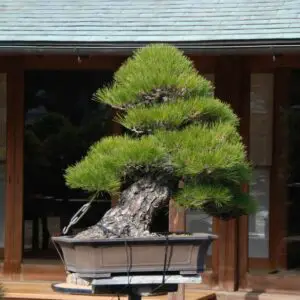
Japanese black pine (slanting)
If your tree is slanting or has more branches on one side, make sure to slant or face the busher side in the larger section to create a sense of balance and proportion.
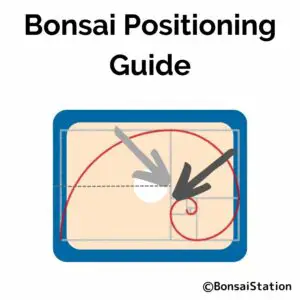
Bonsai positioning guide (top)
Looking down from the top, you can either position the tree at the center or somewhere along the Fibonacci spiral, which might make it visually interesting.
You should also try to create a sense of depth within the pot. Consider positioning the tree so that it appears to be growing out of the pot rather than simply sitting on top of it by putting the lower branches extending over the edge of the pot or angling the tree slightly forward.
Finding the Right Angle
The angle at which you position your bonsai tree in the pot is also important because it can greatly affect its overall appearance and drastically change the impression. You can experiment with different angles by placing the tree in the pot and tilting its position until you find an angle that looks good.
There are several principles to consider in order to choose the best angle for the tree.
Balance and unity
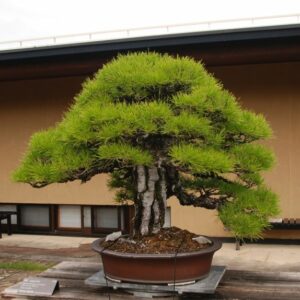
Balance and unity are the first keys. You should look for a sense of equilibrium between the visual weight of the tree and the pot as well as an overall harmonious design. Bonsai can be well-balanced in asymmetrical proportion if there is a sense of cohesiveness within a composition.
It is said that 60% tree volume vs. 40% pot volume is a good balance of bonsai design and neither of them should overpower the other.
Contrast and emphasis
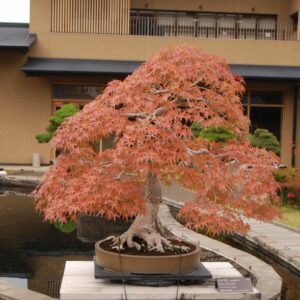
Look for contrast in the shape or texture of the tree and the pot to create visual interest. Determine which part of the tree you want to emphasize such as a unique branching or bark pattern.
In this photo, the orange color of the leaves contrasts beautifully with the white bark.
Movement and rhythm
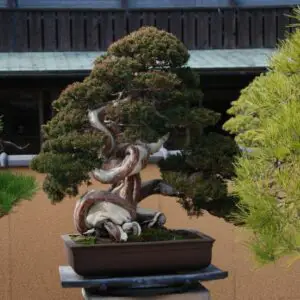
Finally, consider the rhythm created by the tree’s shape and movement, and aim for a composition that has a flow and feels energetic.
Generally, the tree should be positioned with the main trunk slanting slightly toward the front of the pot. This creates a sense of movement and dynamism that is visually appealing.



